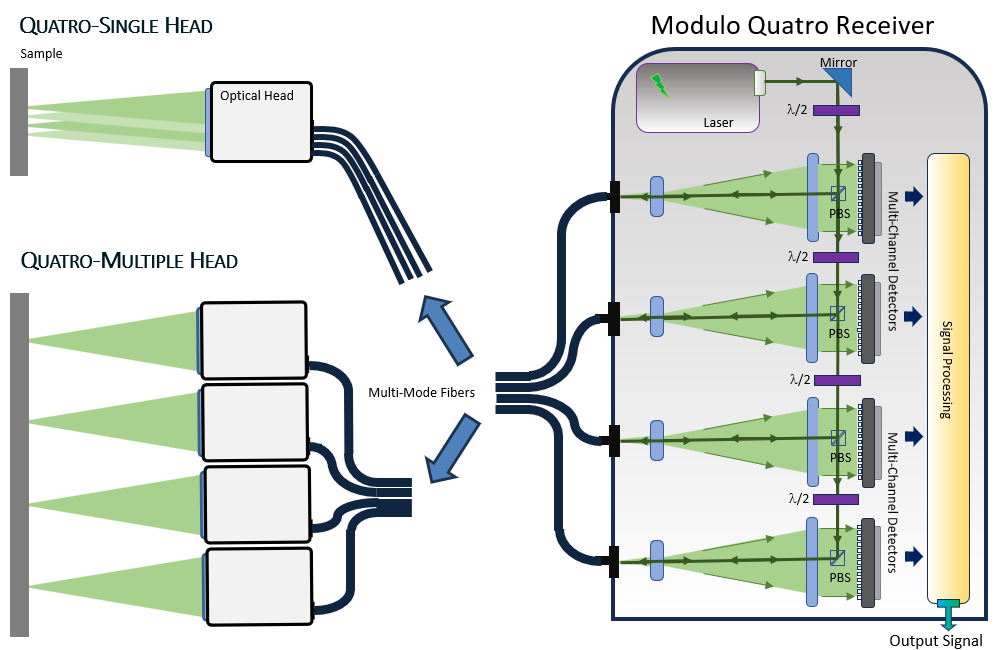The Modulo Quatro.

Four-Point Laser Interferometry
Based on our experience working with teams developing next-generation non-destructive testing solutions, we recognize that unlocking the full potential of laser-ultrasound technology requires a system that is rugged, multi-point, and highly adaptable—our new platform embodies this vision.
The Modulo Quatro harnesses the advantages of multi-channel random quadrature (MCRQ) technology, creating a versatile, multi-point system designed for advanced non-destructive testing applications. It offers the flexibility to route four detection points through a single optical head for rapid scanning or to utilize four independent optical heads, allowing for simultaneous measurements from various angles on a single point or across multiple widely spaced points on a sample. With the Quatro platform, we can customize your laser interferometer to meet the demands of complex and specific testing scenarios.
Based on a streamlined variant of MCRQ the Quatro features the same benefits as our field-proven Quartet, including a Multi-mode Fiber design for large collection efficiency on any type of surface, detector array and parallel processing for efficient processing of multi-speckled light, and patented signal processing based on our ‘random quadrature’ demodulation scheme.
The Quatro also connects directly to a computer, streamlining the measurement process. No external oscilloscope or A/D card is required, making it a versatile and efficient solution for ultrasonic measurements, maintains precision and ease of use.
FEATURES.
Robust & Versatile
The instrument platform was named Modulo due to the adaptability, or “modulability” of the single detector array design. The Quatro features four measurement channels, each an independent measurement point. It can be built to run multiple closely spaced measurement points through a single optical head, or feature four separate optical heads. Closely spaced measurement points drastically increase scan speeds (x 4) while separate optical heads allow for the measurement of different angles simultaneously, to extract the 3D component. And thanks to our proprietary MCRQ technology, it achieves this without requiring high accuracy optical components or positioning, making it exceptionally rugged.
Fiberized Optical Head
A versatile fiberized optical head is easily mounted to fit a variety of measurement conditions and can be set-up for a wide-range of stand-off distances.
Analog & Digital Outputs
The Modulo produces both an analog and digital signal proportional to surface displacement.
High Sensitivity on all Surface Types and Materials
A detector array together with high transmission optics result in high sensitivity. The Modulo produces a stable, demodulated signal even when processing a highly speckled beam. Measurements can be performed on any kind of surface, including rough, porous, rusted and mirror-like.
Rapid Inspection
Efficient electronic processing allows for measurement speeds up to meters per second.
Not Wavelength Dependent
The Modulo can be fitted with a range of internal laser wavelengths ranging from visible to infrared.
SPECIFICATIONS.

Technology
Multi-Channel Random Quadrature

Detection
Out-Of-Plane and or 3D

Configuration
Optical Fiber

Laser Output
400mW to 3W

NESD (out-of-plane motion)
Varies based on model specifications. Contact us for more information.

Detection bandwidth
Up to 60MHz

Dimensions
490 x 450 x 170 mm

Weight
18 kg

Electrical requirements
110V / 220V
50Hz / 60Hz
TECHNOLOGY.
Based on a streamlined version of our Multi-Channel Random Quadrature technology, the Modulo’s novel optical platform allows us to create a single instrument with as many detection points as needed. In this design, the combined sample and reference beans necessary for interferometry are directed straight onto a single detector array which collects both the vertically and horizontally polarized components, allowing us to us to make an instrument that is remarkably compact per measurement channel, all while remaining both highly sensitive and rugged.

More about Multi-Channel Random Quadrature
Design
Laser-based ultrasound receivers rely on interferometry. This means that two interfering beams are necessary for signal detection. A reference beam carries an ideal phase and amplitude profile, while a sample beam is formed by the reflection of the probe light from the sample surface, the contrast created by the interference of the two beams is where the information lies. An ultrasound signal wave, generally produced by a generation laser, introduces a displacement on the surface of the sample. This signal wave modifies the sample beam which is projected against the sample. The interference between the two beams makes it possible to determine the temporal dependence of vibrational surface displacement.
Common laser-based interferometer designs require both the reference and sample beams to be plane waves. However, for most LU systems the random phase distribution of speckles means that only a small portion of the reflected, scattered light can contribute to the amplitude of the measured signal, making the interference inefficient. This is especially true when scanning rough surfaces which tend to scatter the incident light. For most laser-based interferometer designs a highly speckled reflection beam means that most of the power of the probe beam reflected from the surface is unusable and as a result the detection sensitivity of the instrument drops sharply. Due to the limitations of their optical architecture most laser-based interferometers only collect a single or a few speckle in order to maintain phase coherence, which leads to a significant reduction of sensitivity on optically challenging surfaces.
To remedy the problem, the detection aperture size can be enlarged and an array of photodetectors used instead of a single detector such that the instrument collects multiple speckles. The sample beam, composed of multiple speckles, is mixed with the expanded reference beam and then projected onto arrays of photodetectors.
That’s where we come in with our proprietary Multi-Channel Random Quadrature (MCRQ) technology.
Our system does not rely on a standard quadrature detection scheme (which requires the detection of two complimentary signals with a 90° phase difference). MCRQ takes advantage of the random optical phase distribution, assuming that statistically half of signals registered by the photodetectors are in-quadrature and half are out-of-quadrature. The signals from multiple photodetectors (a detector array) are demodulated separately then summed together. This way the overall sensitivity of the measured signal remains high without the need for stabilization as the out-of-quadrature signals will not contribute to the resulting signal. To obtain exceptionally high sensitivity, our Quartet relies on two arrays of 25 photodetectors. Each signal recorded by the array is individually demodulated and processed. Relying on statistical speckle distribution to perform quadratic demodulation makes our MCRQ interferometers (the Quartet and Modulo series) highly sensitive, while forgoing the need for strict optical alignment protocol.
To further improve our systems’ flexibility, our MCRQ interferometers are fitted with a multimode optical fiber and optical head. The sample beam is projected through the fiber and then focused onto the surface being measured using the optical head’s lens system. A portion of the beam then reflects off the surface of the object before being collected by the same optical head and sent back through the fiber. The reference beam is made up of a small part (about 4–5 %) of the incident laser beam that is reflected by the end of the optical fiber. A small piezoelectric actuator is also attached to the end of the fiber, inside the optical head to vary the object path between the lens and the end of the fiber, such that a known Doppler shift based pilot signal is added to the sample beam. We use this pilot signal during processing to perform the sign correction. During backpropagation, the reference and sample beams interfere in the optical fiber.
In the Modulo series, the mixed beam is directed straight onto a single detector array which collects both the vertically and horizontally polarized components. The design allows us to make a line of instruments that is more compact and less expensive per detection point than the Quartet. It also makes for a notably modulable detection scheme; the laser beam can be split into independent optical pathways each with their own detector, allowing us to tailor the receiver to specific applications.
Demodulation
Our MCRQ interferometers use two possible demodulation schemes: a rectified demodulation, and a linear demodulation. The rectified demodulation involves high-pass filtering to remove low-frequency perturbations, followed by the amplification and rectification of the signal. All the individual signals are summed together to obtain the resulting signal. This first scheme efficiently rejects background noise, but the information on the direction of displacement is lost. The second demodulation scheme, or linear demodulation, involves a logic control which detects the signal phase by monitoring the pilot signal. Depending on whether the signal is in-phase or out-of-phase, the logic switches between the two, summing amplifiers to add the appropriate signals constructively. The switch is based on the previously mentioned low-frequency Doppler shift introduced by the piezo-ring attached to the fiber. The low-frequency signal is separated from the high-frequency signal and used to switch the summation logic circuit based on the low-frequency sign. In this way, the displacement direction of the signal is accurately recovered.
Rectified demodulation:

Linear demodulation:


Multi-channel laser interferometric method and apparatus for detection of ultrasonic motion from a surface

Interferometric method and apparatus for linear detection of motion from a surface

